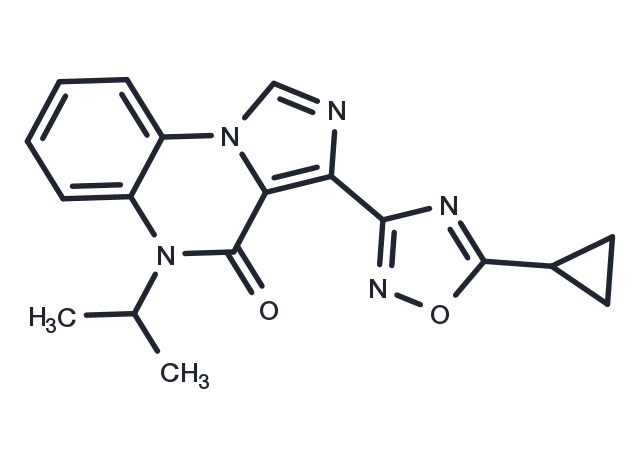Powder: -20°C for 3 years | In solvent: -80°C for 1 year


Panadiplon (FG 10571) is a selective gamma-aminobutyric acid receptor agonist and partial agonist of 5GABAA, a benzodiazepine receptor, used in the treatment of anxiety disorders.Panadiplon exhibits selectivity for 5GABAA receptors versus 1GABAA receptors.

| Pack Size | Availability | Price/USD | Quantity |
|---|---|---|---|
| 1 mg | In stock | $ 143.00 | |
| 5 mg | In stock | $ 360.00 | |
| 10 mg | In stock | $ 530.00 | |
| 25 mg | In stock | $ 859.00 | |
| 50 mg | In stock | $ 1,180.00 | |
| 100 mg | In stock | $ 1,590.00 |


| Description | Panadiplon (FG 10571) is a selective gamma-aminobutyric acid receptor agonist and partial agonist of 5GABAA, a benzodiazepine receptor, used in the treatment of anxiety disorders.Panadiplon exhibits selectivity for 5GABAA receptors versus 1GABAA receptors. |
| In vitro | Panadiplon (10 μg/ml; 48 h; under normoxic conditions; hepatocytes) reduced ATP and glycogen levels by 40% but did not cause an increase in LDH leakage. Cells treated with panadiplon, then exposed to hypoxia conditions, showed a significant level of injury compared to normoxic control cultures, and a further reduction in ATP. No additional decrease in glycogen was observed. In an attempt to prevent panadiplon-mediated injury, glycolytic substrates (dihydroxyacetone or pyruvate) were included during normoxic and hypoxic incubations. Both treatments reduced the level of LDH leakage produced by panadiplon during hypoxia. Cotreatment did not generally increase ATP or glycogen levels (compared to panadiplon treatment groups) during hypoxia, though individual experiments showed a slight increase in ATP levels. During normoxia, both cotreatments with panadiplon resulted in significantly higher glycogen levels than in panadiplon cultures alone. These results suggest that cellular glycogen and subsequently ATP levels are reduced during panadiplon exposure, metabolically predisposing hepatocytes to hypoxic injury.[2] |
| Synonyms | FG10571, FG-10571, FD-10571, PNU 78875, FG 10571, FD10571, FD 10571 |
| Molecular Weight | 335.36 |
| Formula | C18H17N5O2 |
| CAS No. | 124423-84-3 |
Powder: -20°C for 3 years | In solvent: -80°C for 1 year
You can also refer to dose conversion for different animals. More
bottom
Please see Inhibitor Handling Instructions for more frequently ask questions. Topics include: how to prepare stock solutions, how to store products, and cautions on cell-based assays & animal experiments, etc.
Panadiplon 124423-84-3 Membrane transporter/Ion channel Neuroscience GABA Receptor FG10571 PNU78875 FG-10571 PNU-78875 FD-10571 PNU 78875 FG 10571 FD10571 FD 10571 inhibitor inhibit
